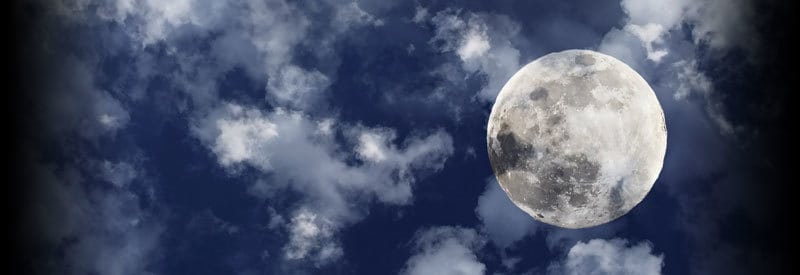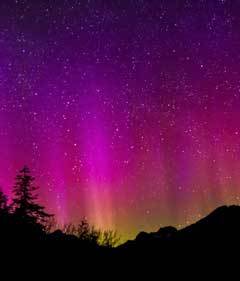Defining The Aurora Borealis – What These Northern Lights Are, And How They Form

Most of us have never observed the Northern Lights in person, but many readers will most definitely have seen images or heard of this meteorological phenomenon. But what exactly is the Aurora Borealis?
The Aurora Borealis, also known as the Northern Lights, is defined as an optical meteorological phenomenon occurring in the upper atmosphere above the Arctic Circle. It appears as bands of colored lights resulting from charged particles in solar winds colliding and reacting with thermospheric gases.
It is probably one of nature's most breathtaking displays, but due to its location, few of us ever get to see an Aurora Borealis occurrence. Situated over the Arctic and Antarctic regions, this phenomenon has also been the source of many awe-inspiring photographs.
This article examines what this multicolored light display is and also how it occurs. It also looks at the facts and characteristics that define it.
What Is The Aurora Borealis?
Several different factors are involved in the creation of the Aurora Borealis, which interactions with each other result in the occurrence of this optical phenomenon. Before examining it in more detail, one needs to obtain a more elaborate definition of this event.
The introduction already provided a brief description of what the Aurora Borealis is, but one needs a more detailed and concise explanation of this occurrence before continuing.
Aurora Borealis Definition

The Aurora Borealis (or Northern Lights) is a meteorological phenomenon that occurs over the Arctic Circle at a height of approximately 90 - 150 km (56 - 93 miles) above the planet's surface. It appears as bands or curtains of multicolored lights (predominantly green, violet, and pink).
It is the result of charged particles in solar winds that collide with gas molecules in the upper atmosphere (specifically the thermosphere and exosphere). The resulting ionization of particles is what causes the visual light display over polar regions.
The name, Aurora Borealis, is derived from the names of gods in Roman Mythology. "Aurora" was the Roman goddess of dawn, while "Borealis" is the god of the north wind. The term was coined by Galileo Galilei, an Italian astronomer, in 1619.
In Norse Mythology, the Aurora Borealis was believed to be a bridge made of fire that extended into the sky.
This meteorological phenomenon also goes by several names, including the Northern Lights, Polar Lights, Merry Dancers, and Aurora Polaris. It also has different names when it occurs in the Southern Hemisphere over Antarctica, but more on that later.
The primary colors that are displayed are luminous green, violet, and pink. It also produces hues of blue, yellow, and occasionally white and orange.
When particles collide with nitrogen, the result typically produces deep red and violet colors. When a collision between charged particles and oxygen occurs, though, it produces the colors green and yellow.

The Aurora Borealis occurs in the magnetosphere, the magnetic field that surrounds and protects the Earth from incoming solar winds. It starts several hundred kilometers above the Earth's surface but extends further than 600,000 kilometers (370,000 miles) in altitude.
(It should not be confused with Earth's 5 atmospheric layers, though, which are categorized according to air density, temperature, meteorological activity, and gravitational force. Technically, the magnetosphere starts in the thermosphere and extends into outer space.)
Types Of Aurora Borealis
Auroras literally come in all shapes and sizes. According to astronomer Dr Stuart Clark, the Aurora Borealis can be divided into 5 categories. The following list names them in order from dimmest to brightest:
- Diffused light appearing close to the horizon that may be hard to observe.
- Bands of light that are similar to arcs but with more of a curvature.
- Arcs appear that extend across the sky.
- Rays are curtain-like light and dark stripes extending into the sky.
- Coronas cover vast portions of the sky and extend from horizon to horizon.
There are, off-course, many other types and variations of this phenomenon, but at the core level, they can be broken down into these 5 types of Aurora Borealis.
How The Aurora Borealis Is Formed
The following steps will serve to illustrate how exactly the Aurora Borealis form and develop:
- 1The Aurora Borealis starts more than 148 million kilometers (92 million miles) away in the center of our solar system, where the Sun produces a wave of charged particles called solar winds that travel to the Earth.
- 2Solar winds are a result of sunspots that occur when magnetic fields on the Sun's surface collide and explode, sending charged particles in the form of solar winds into the solar system.
- 3As the solar winds reach the outer limits of Earth's atmosphere, it comes into contact with gas molecules in the upper atmosphere.
- 4Charged particles from the solar winds collide and interact with the gas molecules, transforming them into a higher state of energy.
- 5When the atoms in the gas molecules get energized, the electrons in the atoms move further away from their nucleus.
- 6When they return to their rested state, the electrons emit light particles called photons that result in the light display we view as the Aurora Borealis.
- 7When a nitrogen molecule is energized, it produces colors with a deep red and violet hue. When an oxygen molecule is energized, it produces the colors green and yellow.
There are other and more detailed processes involved as well, but these steps captured the essence of how the Aurora Borealis forms.
Where Does The Aurora Borealis Occur?
Although we are very familiar with and the vast majority of attention is given to the Aurora Borealis (or Northern Lights), this meteorological phenomenon actually occurs over the polar regions of both the Northern and Southern Hemisphere.

If it occurs in the Southern Hemisphere over Antarctica and surrounding regions, it is known as Aurora Australis or Southern Lights.
In both hemispheres, Auroras are approximately 3 to 6 degrees in width. They are located between 10° and 20° from the geomagnetic poles.
In the Northern Hemisphere, they can be seen in the Arctic Circle and northern countries bordering it. In the Southern Hemisphere, it can be observed over Antarctica, the southernmost part of Argentina, Australia, and New Zealand.
Facts About The Aurora Borealis
- 1The Aurora Borealis is a result of charged particles in solar winds colliding with gases in the upper atmosphere.
- 2The ionization of gas molecules results in the multicolored display over regions in the Arctic Circle.
- 3The primary colors of the Aurora Borealis are luminous green, violet, and pink.
- 4There are 5 types of aurora borealis, categorized according to size and brightness.
- 5The Aurora Borealis occurs in the magnetosphere, Earth's magnetic field that protects the planet from solar winds.
- 6According to Norse Mythology, the Aurora Borealis was believed to be a bridge of fire that reached into the sky.
- 7It appears at an altitude of 90 - 150 km (56 - 93 miles).
- 8It can extend to over 1000 km (621 miles) above the Earth's surface.
- 9The meteorological phenomenon occurs over both poles in the Southern and Northern Hemisphere. It is called the Aurora Australis (or Southern Lights) when it forms over Antarctica.
- 10It occurs between 10° and 20° from the geomagnetic poles.
- 11Some observers claim there are sounds associated with the Aurora Borealis, although this claim has not been scientifically proven yet.
- 12It is clearly visible from space. Some of the most interesting images, putting their size and scale in perspective, have been taken from the International Space Station (ISS).
- 13It occurs on other planets, including Jupiter, Saturn, Neptune, and Uranus.
This is not a complete and exhaustive list but highlights the most important and relevant facts about the Aurora Borealis.
Conclusion
As this article clearly illustrated, the Aurora Borealis is a meteorological phenomenon that occurs on a gigantic scale (literally extending hundreds of miles into the edge of space), producing truly breathtaking lighting displays.
But as also explained, it is a natural phenomenon with a clear scientific explanation that has been widely researched throughout the last few centuries. And today, we understand even more about the Aurora Borealis than ever before.
It may not be the "fire bridge to the sky" as the North Germanic people believed, but that does not take anything away from the feelings of awe and magic this spectacular phenomenon evokes.
Never miss out again when another interesting and helpful article is released and stay updated, while also receiving helpful tips & information by simply clicking on this link .
Until next time, keep your eye on the weather!
